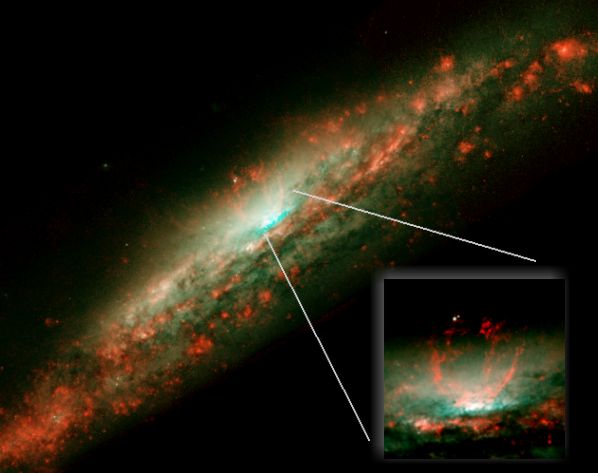Explanation: Edge-on spiral galaxy NGC 3079 is a mere 50 million light-years away toward the constellation Ursa Major. Shown in this stunning false-color Hubble Space Telescope image, the galaxy's disk - composed of spectacular star clusters in winding spiral arms and dramatic dark lanes of dust - spans some 70,000 light-years. Still, NGC 3079's most eye-catching features are the pillars of gas which tower above a swirling cosmic cauldron of activity at the galaxy's center. Seen in the close-up inset at lower right, the pillars rise to a height of about 2,000 light-years and seem to lie on the surface of an immense bubble rising from the galactic core. Measurements indicate that the gaseous pillars are streaming away from the core at 6 million kilometers per hour. What makes this galaxy's cauldron bubble? Astronomers are exploring the possibility that the superbubble is formed by winds from massive stars. If so, these massive stars were likely born all at once as the galactic center underwent a sudden burst of star formation.
1999 2000 2001 2002 2003 2004 2005 2006 2007 2008 2009 2010 2011 2012 2013 2014 2015 2016 2017 2018 2019 2020 2021 2022 2023 2024 2025 |
Январь Февраль Март Апрель Май Июнь Июль Август Сентябрь Октябрь Ноябрь Декабрь |
NASA Web Site Statements, Warnings, and Disclaimers
NASA Official: Jay Norris. Specific rights apply.
A service of: LHEA at NASA / GSFC
& Michigan Tech. U.
|
Публикации с ключевыми словами:
звездообразование - активная галактика - active galaxy - star formation - superbubble - NGC 3079 - сверхпузырь
Публикации со словами: звездообразование - активная галактика - active galaxy - star formation - superbubble - NGC 3079 - сверхпузырь | |
См. также:
Все публикации на ту же тему >> | |
